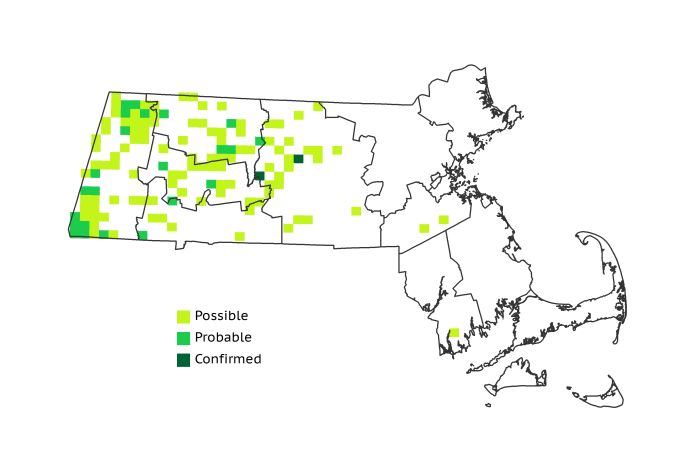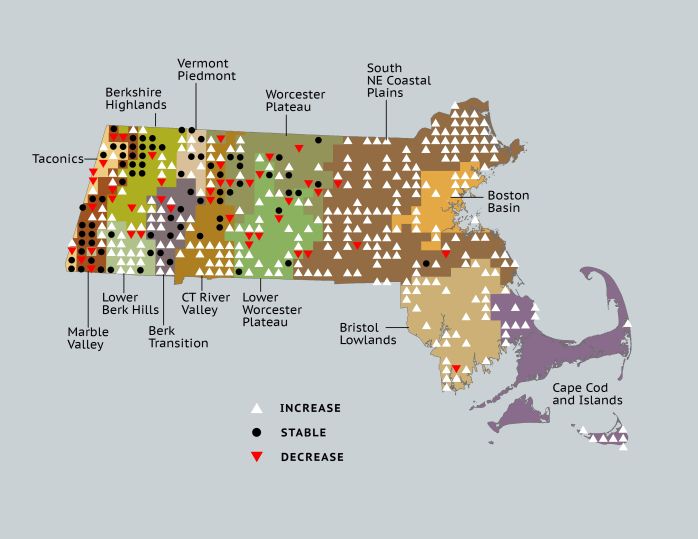Find a Bird
Turkey Vulture
Cathartes aura

Fairly widespread and strongly increasing
“I eat like a vulture. Unfortunately the resemblance doesn’t end there.” – Groucho Marx
The two-toned silhouette of a soaring Turkey Vulture is familiar to just about everyone. Whether they’re cruising along the shoulder of the Mass Pike for fresh roadkill or gliding over Quabbin Reservoir treetops in search of dead deer, ominous-looking Turkey Vultures have become fairly commonplace in the Commonwealth. Far from spreading disease, these efficient necrophages keep our roadways tidy by consuming roadkill. Given their steadily increasing numbers, it is incredible to think that, just a century ago, the notion of Turkey Vultures ever breeding in the Bay State was laughable at best.
Historic Status
In 1878, Joel Asaph Allen noted in his annotated list of the birds of Massachusetts that the more southerly breeding “Turkey Buzzards” had been seen at least twice in Massachusetts, but not since 1864 (Allen1878). Had he compared notes with William Brewster, he would have known that one was also found in Waltham in 1867 (Brewster 1906). These few pilgrims were the beginning of a colonization that would lead to a change in the Turley Vulture’s status from “accidental” visitor in Massachusetts to breeding species. It would take another 80 years before positive evidence of breeding was established. First, an immature bird was found dead on Mount Everett in 1945; but on August 29, 1954, the question of breeding was resoundingly answered in the affirmative when a nest containing two downy young was discovered in Tyringham (Veit & Petersen 1993).
Atlas 1 Distribution
The Atlas 1 distribution of Turkey Vultures in Massachusetts offers an interesting snapshot of a range expansion in progress. The regions from the Taconic Mountains to the Worcester Plateau held the bulk of the occupied blocks in Atlas 1. Generally, percentages of block occupancy were higher in the western ecoregions and dropped eastward. Turkey Vulture breeding activity fell sharply east of the Worcester Plateau, with the species occupying only 1.9% of Coastal Plains and 0.9% in the Bristol/Narragansett Lowlands.
Atlas 2 Distribution and Change
The breeding distribution of Turkey Vultures in the state was more uniform by the end of Atlas 2. Most western ecoregions reported Turkey Vultures soaring through the majority of blocks, though the Berkshire Highlands and Worcester Plateau both contained notable areas where vultures were absent. Turkey Vultures had a strong presence in the Coastal Plains, especially Essex County, though they were somewhat scarcer within the well-developed flatlands of the Boston Basin. The Bristol/Narragansett Lowlands also had a fair number of Turkey Vultures present during the Safe Date period but no Confirmed breeding. Conversely, mainland Cape Cod had Turkey Vultures Confirmed to be nesting in 3 blocks despite a genuine scarcity of sightings elsewhere in the ecoregion. The almost-complete presence of Turkey Vultures on Nantucket suggests that the species has begun breeding there as well.
Atlas 1 Map

Atlas 2 Map

Atlas Change Map

Ecoregion Data
Atlas 1 | Atlas 2 | Change | ||||||
Ecoregion | # Blocks | % Blocks | % of Range | # Blocks | % Blocks | % of Range | Change in # Blocks | Change in % Blocks |
Taconic Mountains | 10 | 62.5 | 7.8 | 9 | 36.0 | 2.0 | -1 | -6.7 |
Marble Valleys/Housatonic Valley | 26 | 66.7 | 20.3 | 29 | 74.4 | 6.5 | 3 | 7.7 |
Berkshire Highlands | 15 | 27.3 | 11.7 | 26 | 47.3 | 5.8 | 10 | 18.9 |
Lower Berkshire Hills | 7 | 25.0 | 5.5 | 20 | 64.5 | 4.5 | 12 | 44.4 |
Vermont Piedmont | 5 | 29.4 | 3.9 | 12 | 70.6 | 2.7 | 5 | 41.7 |
Berkshire Transition | 12 | 31.6 | 9.4 | 29 | 72.5 | 6.5 | 13 | 41.9 |
Connecticut River Valley | 12 | 21.4 | 9.4 | 37 | 56.9 | 8.2 | 20 | 41.7 |
Worcester Plateau | 19 | 24.4 | 14.8 | 39 | 44.3 | 8.7 | 3 | 6.3 |
Lower Worcester Plateau | 16 | 21.6 | 12.5 | 44 | 55.0 | 9.8 | 16 | 29.6 |
S. New England Coastal Plains and Hills | 5 | 1.9 | 3.9 | 137 | 48.4 | 30.5 | 110 | 48.7 |
Boston Basin | 0 | 0.0 | 0.0 | 15 | 26.8 | 3.3 | 15 | 27.3 |
Bristol and Narragansett Lowlands | 1 | 0.9 | 0.8 | 33 | 28.9 | 7.3 | 30 | 29.7 |
Cape Cod and Islands | 0 | 0.0 | 0.0 | 19 | 13.2 | 4.2 | 17 | 14.2 |
Statewide Total | 128 | 13.2 | 100.0 | 449 | 43.3 | 100.0 | 253 | 30.5 |
Notes
The Turkey Vulture shows significant increasing Breeding Bird Survey trends, both in the mid-Atlantic region and the whole Eastern US. Vultures and other wide-ranging foragers are difficult to analyze using Atlas methods. The maps certainly overestimate the Possible range of breeding for the species. There are many nonbreeding individuals present during the breeding season, and each breeding pair ranges far and wide to find food for their brood. This increases the likelihood that we will overestimate the breeding footprint, if we assume that each sighting is independent. However, this species is likely underestimated when using the Confirmed records. Vultures nest on talus slopes, remote rocky outcrops in the woods, and abandoned buildings, and their nests are notoriously difficult to find.



